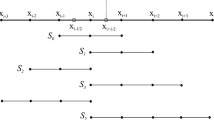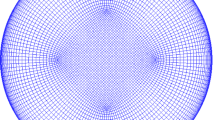Abstract
Verification and validation of laminar, transitional, and fully turbulent flow simulations using URANS and hybrid RANS/LES (HRL) are performed for a capillary tube at Re = 500–5100 and for nozzle flow at Re = 500, 3500, and 6500. For the capillary tube case, good predictions for Re ≤ 1000 and ≥4000 were obtained using laminar and fully turbulent URANS models, respectively. A transition-sensitive URANS model performed well for the entire Re range, suggesting the ability to provide a universal model for laminar and turbulent URANS solutions, provided that the inlet turbulence intensity can be accurately prescribed. For the nozzle flow simulations, good predictions for Re = 500 and 6500 were obtained using laminar and fully turbulent URANS and HRL simulations, respectively. For the transitional case, Re = 3500, turbulent simulations performed well in the separated flow regions but were under-predictive in the throat region. The hybrid RANS/LES simulations performed better than URANS in the separated flow region. The most commonly used hybrid RANS/LES models failed either to trigger turbulence or transition to LES mode for low background turbulence. A new dynamic hybrid RANS/LES model [Bhushan and Walters, Physics of Fluids, 24, 015103, 2012] did not show such a deficiency and provided the best comparison with experimental data for the two higher Re cases.












Similar content being viewed by others
References
Adedoyin, A., D. K. Walters, and S. Bhushan. Assessment of modeling and discretization error in finite-volume large eddy simulations. ASME Paper No. IMECE2006-14918, 2006.
Alam, M. F., D. K. Walters, and D. S. Thompson. Simulations of separated flow around an airfoil with ice shape using hybrid RANS/LES models. In: AIAA-2011-3972, 29th AIAA Applied Aerodynamics Conference, Honolulu, Hawaii, June 27–30, 2011.
Armaly, B. F., F. Durst, J. C. F. Peireira, and B. Schonung. Experimental and theoretical investigation of backward-facing step flow. J. Fluid Mech. 127:473–496, 1983.
Bertalis, N., E. Balaras, B. Parvinian, and K. Kiger. A numerical and experimental investigation of transitional pulsatile flow in a stenosed channel. J. Biomech. Eng. 127:1147–1157, 2005.
Bhushan, S., P. Carrica, J. Yang, and F. Stern. Scalability and validation study for large scale surface combatant computations using CFDShip-Iowa. Int. J. High Perform. Comput. Appl. 25:466–487, 2011.
Bhushan, S., and D. K. Walters. A dynamic hybrid RANS/LES modeling framework. Phys. Fluids 24:015103, 2012.
Burgreen, G. W., J. F. Antaki, Z. J. Wu, and J. A. Holmes. Computational fluid dynamics as a development tool for rotary blood pumps. Artif. Organs 25(4):600–607, 2001.
Durst, F. and C. Tropea. Turbulent, backward-facing step flows in two-dimensional ducts and channels. In: Proceedings of the 3rd International Symposium on Turbulent Shear Flows, University of California, Davis, 1981, pp. 18.1–18.5.
FLUENT 6.3, User Guide FLUENT 6.3. Lebanon, NH: FLUENT Inc.
Fraser, K. H., M. E. Taskin, B. P. Griffith, and Z. J. Wu. The use of computational fluid dynamics in the development of ventricular assist devices. Med. Eng. Phys. 33:263–280, 2011.
Ge, L., H. L. Leo, F. Sotiropoulos, and A. P. Yoganathan. Flow in a mechanical bileaflet heart valve at laminar and near-peak systole flow rates: CFD simulations and experiments. J. Biomech. Eng. 127:782–797, 2005.
Hariharan, P., M. Giarra, V. Reddy, S. W. Day, K. B. Manning, S. Deutsch, S. F. C. Stewart, M. R. Myers, M. Berman, G. W. Burgreen, E. G. Paterson, and R. A. Malinauskas. Multilaboratory particle image velocimetry analysis of the FDA benchmark nozzle model to support validation of computational fluid dynamics simulations. J. Biomech. Eng. 133:041002, 2011.
Hudy, L. M., A. M. Naguib, W. M. Humphreys, and S. M. Bartram. Particle image velocimetry measurements of a two/three-dimensional separating/reattaching boundary layer downstream of an axisymmetric backward-facing step. AIAA Paper 2005-0114 in 43th AIAA Aerospace Sciences Meeting & Exhibit, Reno, NV, January 2005.
International Journal of Computational Fluid Dynamics. Special issue: RANS CFD modelling into a second century, 23(4), 2009.
Issa, R. I. Solution of the implicit discretized fluid flow equations by operator splitting. Mechanical Engineering Rep. FS-82-15, Imperial College, London, 1982.
Kameneva, M., G. W. Burgreen, K. Kono, et al. Effects of turbulent stresses on mechanical hemolysis: experimental and computational analysis. ASAIO J. 50:418–423, 2004.
Kang, H. S., S. Chester, and C. Meneveau. Decaying turbulence in an active-grid-generated flow and comparisons with large-eddy simulation. J. Fluid Mech. 480:129–160, 2003.
Langtry, R. B. and F. R. Menter. Transition modeling for general CFD applications in aeronautics. American Institute for Aeronautics and Astronautics (AIAA) Paper 2005-522, 2005.
Launder, B. E., and D. B. Spalding. The numerical computation of turbulent flows. Comput. Methods Appl. Mech. Eng. 3:269–289, 1974.
Lyons, D. C., L. J. Peltier, F. J. Zajaczkowski, and E. G. Paterson. Assessment of DES models for separated flow from a hump in a turbulent boundary layer. J. Fluids Eng. 131:111203, 2009.
Mallinger, F., and D. Drikakis. Instability in three-dimensional unsteady stenotic flows. Int. J. Heat Fluid Flow 23:657–663, 2002.
Mayle, R. E., and A. Schulz. The path to predicting bypass transition. ASME J. Turbomach. 119:405–411, 1997.
Medvitz, R. B., D. A. Boger, V. Izraelev, et al. Computational fluid dynamics design and analysis of a passively suspended Tesla pump left ventricular assist device. Artif. Organs 35(5):522–533, 2010.
Menter, F. R. Two-equation eddy-viscosity turbulence models for engineering applications. AIAA J. 32(8):1598–1605, 1994.
Menter, F. R., and Y. Egorov. The scale-adaptive simulation method for unsteady turbulent flow predictions. Part 1: Theory and model description. Flow Turbul. Combust. 85:113–138, 2010.
Menter, F. R., R. Langtry, and S. Volker. Transition modelling for general purpose CFD codes. Flow Turbul. Combust. 77:277–303, 2006.
Mittal, R., S. P. Simmons, and F. Najjar. Numerical study of pulsatile flow in a constricted channel. J. Fluid Mech. 485:337–378, 2003.
Sagaut, P., and S. Deck. Large eddy simulation for aerodynamics: status and perspectives. Philos. Trans. R. Soc. A 367:2849–2860, 2009.
Shih, T. H., W. W. Liou, A. Shabbir, and J. Zhu. A new k–e eddy-viscosity model for high Reynolds numbers turbulent flows model development and validation. Comput. Fluids 24(3):227–238, 1995.
Sotiropoulos, F. Computational fluid dynamics for medical device design and evaluation: are we there yet? Cardiovasc. Eng. Tech. 3(2):137–138, 2012.
Spalart, P. Detached-eddy simulation. Annu. Rev. Fluid Mech. 41:181–202, 2009.
Spalart, P. R., and S. R. Allmaras. A one-equation turbulence model for aerodynamic flows. Recherche Aerospatiale 1:5–21, 1994.
Stern, F., R. Wilson, and J. Shao. Quantitative approach to V&V of CFD simulations and certification of CFD codes. Int. J. Numer. Methods Fluids 50:1335–1355, 2006.
Stewart, S. F. C., E. G. Paterson, G. W. Burgreen, P. Hariharan, M. Giarra, V. Reddy, S. W. Day, K. B. Manning, S. Deutsch, M. R. Berman, M. R. Myers, and R. A. Malinauskas. Assessment of CFD performance in simulations of an idealized medical device—results of FDA’s first computational interlaboratory study. Cardiovasc. Eng. Tech. 2012. doi:10.1007/s13239-012-0087-5.
Tan, F. P., G. Soloperto, S. Bashford, et al. Analysis of flow disturbance in a stenosed carotid artery bifurcation using two-equation transitional and turbulence models. J. Biomech. Eng. 130(6):061008, 2008.
Tan, F. P. P., N. B. Wood, G. Tabor, and X. Y. Xu. Comparison of LES of steady transitional flow in an idealized stenosed axisymmetric artery model with a RANS transitional model. J. Biomech. Eng. 133:051001, 2011.
Varghese, S. S., S. H. Frankel, and P. F. Fischer. Direct numerical simulation of stenotic flows, part 1: steady flow. J. Fluid Mech. 582:253–280, 2007.
Varghese, S. S., S. H. Frankel, and P. F. Fischer. Modeling transition to turbulence in eccentric stenotic flows. J. Biomech. Eng. 130:014503, 2008.
Walters, D. K., S. Bhushan, M. F. Alam, and D. S. Thompson. Investigation of a dynamic hybrid RANS/LES modeling methodology for finite-volume CFD simulations. In: 9th International Symposium on Engineering Turbulence Modelling and Measurements, ETMM9, Thessaloniki, Greece, 6–8 June 2012.
Walters, D. K., and D. Cokljat. A three-equation eddy-viscosity model for reynolds-averaged Navier–Stokes simulations of transitional flow. ASME J. Fluids Eng. 130:121401, 2008.
White, F. M. Fluid Mechanics (5th ed.). Boston: McGraw Hill, 2003.
Wilcox, D. C. Reassessment of the scale-determining equation for advanced turbulence models. AIAA J. 26(11):1299–1310, 1998.
Acknowledgments
This research was funded by NSF under Grant No. EPS-0903787 and by NASA under Grant No. NNX 10AN06A.
Author information
Authors and Affiliations
Corresponding author
Additional information
Associate Editor Ajit P. Yoganathan oversaw the review of this article.
Rights and permissions
About this article
Cite this article
Bhushan, S., Walters, D.K. & Burgreen, G.W. Laminar, Turbulent, and Transitional Simulations in Benchmark Cases with Cardiovascular Device Features. Cardiovasc Eng Tech 4, 408–426 (2013). https://doi.org/10.1007/s13239-013-0155-5
Received:
Accepted:
Published:
Issue Date:
DOI: https://doi.org/10.1007/s13239-013-0155-5




